Content from the Brookings-Tsinghua Public Policy Center is now archived. Since October 1, 2020, Brookings has maintained a limited partnership with Tsinghua University School of Public Policy and Management that is intended to facilitate jointly organized dialogues, meetings, and/or events.
The Trump administration entered office determined to halt North Korea’s nuclear and missile advances. The administration declared the era of “strategic patience” over and announced a strategy of maximum pressure. The strategy achieved some gains, such as China’s decision to ban coal imports from North Korea for the remainder of 2017, India’s distancing from North Korea, and several European and African countries’ efforts to crack down on North Korean illicit revenue-generating networks.
On net, though, North Korea remains undeterred from advancing its nuclear and missile programs, Kim Jong-un’s hold on power appears firm, North Korea-China trade remains significant, and the North Korean economy does not show signs of cracking.
Mission muddle?
While the North Korean regime is united around the goal of demonstrating a credible nuclear strike capability, the Trump administration appears disjointed in its response. The Department of Defense has responded to North Korean provocations with demonstrations of its strategic deterrent and missile defense capabilities. President Trump has been all over the map on North Korea, from blustering that North Korea will not succeed in its nuclear and missile programs to proclaiming that he would be honored to meet with Kim Jong-un under the right circumstances.
Vice President Pence continues to stress publicly that “all options” (e.g., military options) remain on the table. Director of Central Intelligence Pompeo has alluded publicly to the need for regime change. Meanwhile, Secretary of State Tillerson continues to try to coax North Korea toward dialogue, including by emphasizing that the United States does not seek regime change, regime collapse, accelerated unification, or troops north of the 38th parallel.
Compounding these problems, the gap between Washington’s and Beijing’s approaches to North Korea has widened, as has the gap between Washington and Seoul. As a consequence, North Korea appears to have discounted the risk of defying Washington’s demands.
Given the pace of North Korea’s advances and the risk that a nuclear-capable North Korean regime poses to the United States and its allies, the Trump administration should coalesce around a single coherent strategy for giving diplomacy with North Korea one last shot, all the while being prepared to accelerate efforts to strengthen deterrence if diplomacy fails.
National Interests
The first step is to achieve internal clarity on what top national interests the United States must protect. In the case of North Korea, the United States should concentrate on protecting the U.S. homeland against attack or blackmail of an attack, preventing proliferation of nuclear or missile technology from North Korea, upholding the credibility of alliance commitments, and preventing war.
Near-Term Objective
The second step is to identify a near-term goal that maximally protects top U.S. interests and is plausibly within the realm of acceptability for other key actors such as North Korea, China, South Korea, Russia, and Japan. The goal of complete, verifiable, and irreversible denuclearization does not meet these parameters. North Korea will not abandon or negotiate away its nuclear and missile programs, given its conviction that they are key to the regime’s survival.
A more realistic objective would be a verifiable freeze on North Korea’s nuclear and missile programs, with verification through an inspections regime similar to the one in place in Iran. A freeze would create space for negotiations on a cap on North Korea’s nuclear and missile programs. In other words, freeze then cap. None of this would invalidate the agreed upon goal of the September 2005 Six-Party Talks to achieve eventual denuclearization of the Korean Peninsula. It would merely push the goal of denuclearization out into the future and allow for tangible steps to be pursued now to protect U.S. interests.
Joint Efforts Among Five-Parties
The third step is to secure buy-in for this more modest approach from key partners, first with our allies in Seoul and Tokyo, and then with Beijing and Moscow. Although there is no guarantee that Pyongyang would respond to a unified freeze-and-cap push from all five parties, there is a high likelihood that anything short of it would not move the policy needle with Pyongyang.
To give credibility to any push for a freeze-and-cap, the five parties (United States, South Korea, Japan, China, Russia) will need to come to terms among themselves—before any approach to Pyongyang—about the incentives and disincentives they would be prepared to put on the table and the sequencing. Coordination is key, particularly about the types of coercive steps all parties would be prepared to take in the event that North Korea conducts further provocations or reneges on negotiated commitments. This will require diplomatic activism, first through shuttle diplomacy among the various capitals and eventually through five-party talks.
Bringing Beijing and Moscow on Board
To overcome reflexive Chinese and Russian opposition to the appearance of ganging up on North Korea, the administration will need to be prepared to respect their legitimate security interests on the Korean Peninsula. That includes by making clear that the United States is focused narrowly on protecting itself and its allies from North Korea’s nuclear and missile programs and does not have strategic designs to drive wedges between Pyongyang and its neighbors, turn Pyongyang against any of its neighbors, or accelerate the collapse of the Kim regime.
The administration also will need to be forceful in disabusing both parties of any hope that China’s proposed “dual freeze” of North Korean nuclear and missile tests and U.S.-South Korean combined military exercises has any traction, given that the United States, South Korea, and seemingly also North Korea find it unacceptable.
Additionally, Beijing and Moscow will need to be convinced that this effort reflects our final push to address the North Korean challenge through diplomatic means. If Beijing and Moscow are not interested in participating in this approach, the United States will be left with no choice but to shift to a posture of hard containment and maximum deterrence of North Korea. Such a posture would include scaling up regional missile defense, bringing strategic assets into theater, accelerating maritime interdiction efforts, intensifying a campaign to isolate North Korea from the rest of the world, and increasing the internal stress on the Kim regime.
In effect, Washington would pivot from pursuing a diplomatic outcome to concentrating its significant capabilities on:
- Denying the North Korean regime the strategic objectives it seeks through its weapons program, including the ability to extort and intimidate South Korea and Japan;
- Signaling clearly to Pyongyang that any attack on the United States or its allies—or any proliferation of nuclear and missile technology—would be met with an overwhelming response; and
- Intensifying pressure on the political system for the purpose of accelerating the collapse of the Kim regime.
In making the presentation to the Chinese, senior U.S. officials should also be direct in private in emphasizing that China’s current approach to the Korean Peninsula is not working. It has delivered a deterioration in relations with both Pyongyang and Seoul, diminished influence over North Korea’s nuclear and missile programs, and increasing friction with Washington. Beijing also should be forced to confront the probability that Pyongyang will shift its ire toward China in the future. The odds of escalating animosity between Beijing and Pyongyang will grow as Beijing becomes more assertive in pushing for a return to a Sino-centric order in Asia—a regional order that stands in direct opposition to Pyongyang’s identification of its strategic interests. And when the North Korean regime unravels in the future under the weight of outside pressure and internal contradictions, North Korea will remain China’s neighbor, and China’s mess to manage. In other words, China has an incentive to take steps now with us and others to get a grip around the problem, because its current approach is not working and future scenarios are not promising for China’s strategic interests.
China has an incentive to take steps now with us and others to get a grip around the problem.
The goal would be to cause Beijing and Moscow to conclude that their long-term interests are best served by working in the short-term to push Pyongyang to accept a freeze-and-cap as the best available option for ensuring the Kim regime’s survival. If Beijing or Moscow balk, Washington would have thus set the predicate for hard containment and maximum deterrence. And because Beijing’s and Moscow’s inaction would have contributed to that outcome, they would be back-footed in pushing back against any such U.S. actions.
This approach doesn’t hold any magic keys to solving the North Korea problem, but it would—at a minimum—give direction and focus to Trump administration efforts to get a handle on the growing challenges presented by North Korea. A key lesson of the Iran nuclear negotiations is that progress was only possible when the international community was united and Iran was under stress. Taking a more modest approach of pursuing a freeze then cap would hold the best prospect for getting Washington, Beijing, Seoul, Tokyo, and Moscow aligned behind a shared objective. And the more that these five parties are pulling in the same direction, the higher the probability that conditions will ripen for resumption of a genuine diplomatic process leading to an outcome that maximally protects American interests.
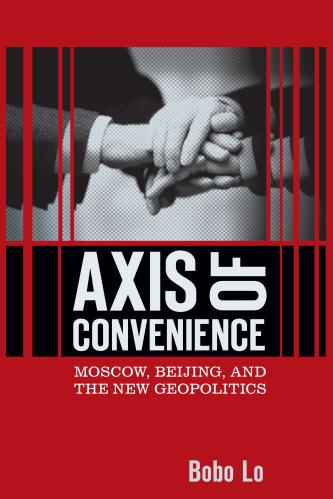
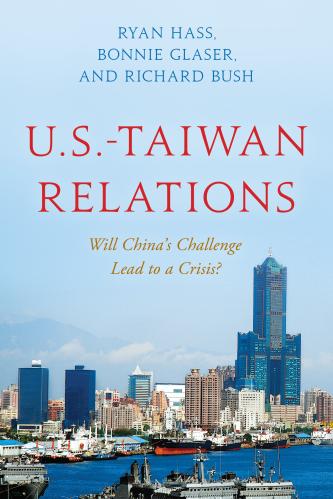

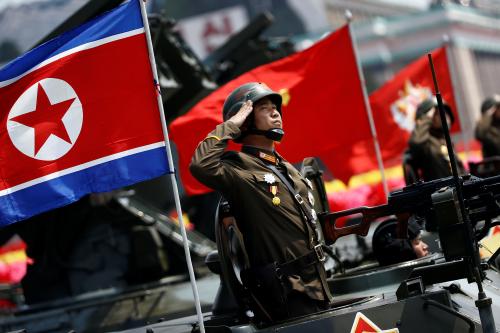

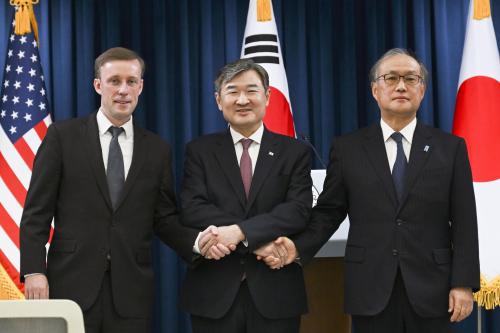
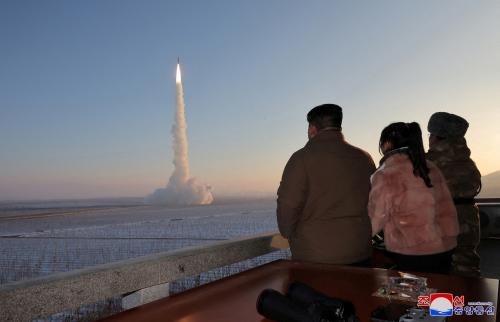
Commentary
Seizing the initiative on North Korea
August 4, 2017